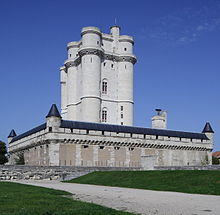Vincennes
| Vincennes | ||
|---|---|---|

|
|
|
| region | Île-de-France | |
| Department | Val-de-Marne | |
| Arrondissement | Nogent-sur-Marne | |
| Canton |
Fontenay-sous-Bois Vincennes (main town) |
|
| Community association |
Métropole du Grand Paris and Paris Est Marne et Bois |
|
| Coordinates | 48 ° 51 ' N , 2 ° 26' E | |
| height | 47-69 m | |
| surface | 1.91 km 2 | |
| Residents | 49,891 (January 1, 2017) | |
| Population density | 26,121 inhabitants / km 2 | |
| Post Code | 94300 | |
| INSEE code | 94080 | |
| Website | www.vincennes.fr | |
Vincennes is a French city with 49,891 inhabitants (as of January 1, 2017) in the greater Paris area , located southeast of the center in the Marne Valley and seamlessly connected to the urban area of the French capital. Vincennes is part of the Val-de-Marne department in the Île-de-France region . Vincennes Castle and Fort-Neuf are in the city .
history
The origin and history of Vincennes is closely linked to the castle there, the château de Vincennes . In the 12th century, King Louis VII of France decided to declare the forest of Vincennes a royal hunting area and had a castle built. Over the years this has been redesigned and expanded again and again. The medieval buildings are the only structures of a royal residence from the Middle Ages in France.
In 1162, Louis VII had part of the Vincennes forest surrounded by a wall and a hunting pavilion built in it. In the 13th century, King Philip August began building a castle, which was built under Louis IX. has been completed. From 1270 to 1350 the castle was the favorite place of residence of the French kings. Two royal weddings were celebrated in the palace ( Philip III and Philip V ) and two kings died there ( Louis X and Charles IV ). Even after the Hundred Years War , kings resided in Vincennes (especially Louis XI. , Franz I and Henry II ). In 1661 a peace treaty between France and Lorraine was concluded in Vincennes . Louis XIV also moved the seat of the Ordre de Saint-Michel from Mont-Saint-Michel here. Only with the death of Louis XIV in 1715 was Vincennes abandoned as a residence.
The state prison in the Donjon of Vincennes , in which the Marquis de Sade , the revolutionary Mirabeau and the enlightener Denis Diderot were temporarily imprisoned, was closed in 1784.
In the 18th century, different branches of industry settled in the castle (porcelain manufacture, faience painters and an armory). Vincennes only became a city in 1787. With the new construction of Fort-Neuf (1841) Vincennes became a garrison town and between 1817 and 1856 there were around 4,000 inhabitants. In 1861 there were already 5,800.
In 1900 the Vélodrome de Vincennes served as the main venue for the II. Modern Olympic Games .
The Vincennes castle was in 1917 the scene of the execution of Mata Hari , a German spy of the World War II.
In 1969 the reform university Paris VIII was opened in the city ; but this was moved to Saint-Denis in 1980 .
Attractions
See: List of Monuments historiques in Vincennes
Trivia
The French also call the castle of Vincennes the “Versailles of the Middle Ages” because several medieval kings resided there (see above).
Town twinning
- Castrop-Rauxel (Germany)
- Lambeth (United Kingdom)
- Montigny-le-Tilleul (Belgium)
- Tomar (Portugal)
- Vincennes (Indiana) (United States)
Personalities
Sons and daughters:
Middle Ages:
- Joan of Bourbon (1338–1378), Queen of France
- Charles V (1338–1380), King of France
- Philippe de Valois, duc d'Orléans (1336–1375), youngest son of King Philip VI. from France
Modern times:
- Anne Geneviève de Bourbon-Condé (1619–1679), Duchess of Longueville, sister of the Grand Condé
- Jacques Bainville (1879–1936), writer, member of the Académie française
- Marie Anne de Bourbon , Princesse de Conti (1666–1739), illegitimate daughter of Louis XIV.
- Isidore Canevale (1730–1786), Austrian architect of French origin
- Michel Droit (1923–2000), writer, member of the Académie française
- André Hardellet (1911–1974), writer
- Ivan Jullien (1934–2015), jazz trumpeter and composer
- Jérôme Lambert (* 1957), politician, member of the National Assembly
- Serge Le Tendre (* 1946), French comic book author and copywriter
- Pierre Messmer (1916–2007), French Prime Minister
- Michel Tognini (* 1949), pilot and astronaut
- Jules Toutain (1865–1961), classical archaeologist and historian of religion
- Illustration by Daniel Meisner from 1625: S. Vincens; Much dogs are dead of the rabbit ( digitized version )
literature
- Le Patrimoine des Communes du Val-de-Marne . 2nd Edition. Flohic Editions, Charenton-le-Pont 1994, ISBN 2-908958-94-5 .


